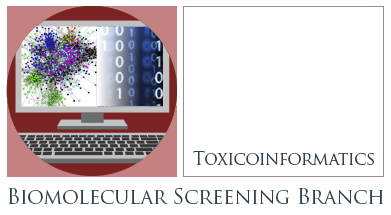Much of the work carried out by DTT is in support of the National Toxicology Program (NTP), an interagency partnership of the Food and Drug Administration, National Institute for Occupational Safety and Health, and NIEHS.

Leader, Toxicoinformatics
Research Summary
The Toxicoinformatics Group leads the development of data analytic approaches related to Tox21 data and provides informatics support for a variety of projects within the Biomolecular Screening Branch and across the National Toxicology Program.
Specific projects include:
- Development of toxicogenomic models that predict apical toxicological outcomes
- Evaluation of methods for scaling toxicogenomic technologies
- In vitro / In vivo extrapolation
- Analytics pipeline development for Tox21 high throughput screening data
- Development of network-based inference approaches for biological read-across using Tox21 data
- Development of software for genomic benchmark dose analysis
Scientists & Staff

Leader, Toxicoinformatics

Mathematical Statistician

Zicong Wang
Contractor - Software Developer
Recent Publications
-
Yang C, Lin T, Hsieh J, Hsu K, Chiueh P. Establishment of an Integrated Model for Predicting Compound Mutagenicity with a Feature Importance Analysis.
Journal of chemical information and modeling.
2025 Nov 10;65(21):11558-11571.
[
AbstractYang C, Lin T, Hsieh J, Hsu K, Chiueh P. Establishment of an Integrated Model for Predicting Compound Mutagenicity with a Feature Importance Analysis. Journal of chemical information and modeling. 2025 Nov 10
]
-
Pannala V, Balik-Meisner M, Mav D, Phadke D, Scholl E, Shah R, Casey W, Auerbach S, Wallqvist A. Fenofibrate differentially activates PPARα-mediated lipid metabolism in rat kidney and liver.
Scientific reports.
2025 Oct 22;15(1):36842.
[
AbstractPannala V, Balik-Meisner M, Mav D, Phadke D, Scholl E, Shah R, Casey W, Auerbach S, Wallqvist A. Fenofibrate differentially activates PPARα-mediated lipid metabolism in rat kidney and liver. Scientific reports. 2025 Oct 22
]
-
Hari A, Balik-Meisner M, Mav D, Phadke D, Scholl E, Shah R, Casey W, Auerbach S, Wallqvist A, Pannala V. Genome-Scale Metabolic Modeling Predicts Per- and Polyfluoroalkyl Substance-Mediated Early Perturbations in Liver Metabolism.
Toxics.
2025 Aug 17;13(8):.
[
AbstractHari A, Balik-Meisner M, Mav D, Phadke D, Scholl E, Shah R, Casey W, Auerbach S, Wallqvist A, Pannala V. Genome-Scale Metabolic Modeling Predicts Per- and Polyfluoroalkyl Substance-Mediated Early Perturbations in Liver Metabolism. Toxics. 2025 Aug 17
]
-
Carstens K, Dönmez A, Hsieh J, Bartmann K, Friedman K, Koch K, Scholze M, Fritsche E. A comparative study of biostatistical pipelines for benchmark concentration modeling of in vitro screening assays.
Computational toxicology (Amsterdam, Netherlands).
2025 Jun 01;34:.
[
AbstractCarstens K, Dönmez A, Hsieh J, Bartmann K, Friedman K, Koch K, Scholze M, Fritsche E. A comparative study of biostatistical pipelines for benchmark concentration modeling of in vitro screening assays. Computational toxicology (Amsterdam, Netherlands). 2025 Jun 01
]
-
Pennell M, Wheeler M, Auerbach S. A hierarchical constrained density regression model for predicting cluster-level dose-response.
Environmetrics.
2024 Nov;35(7):.
[
AbstractPennell M, Wheeler M, Auerbach S. A hierarchical constrained density regression model for predicting cluster-level dose-response. Environmetrics. 2024 Nov
]
More Recent Publications from PubMed
Software
- Tox21 Toolbox
The Tox21 toolbox contains useful tools for accessing and visualizing the Tox21 quantitative high throughput screening (qHTS) 10K library data, as well as integrating with other publicly available data.









